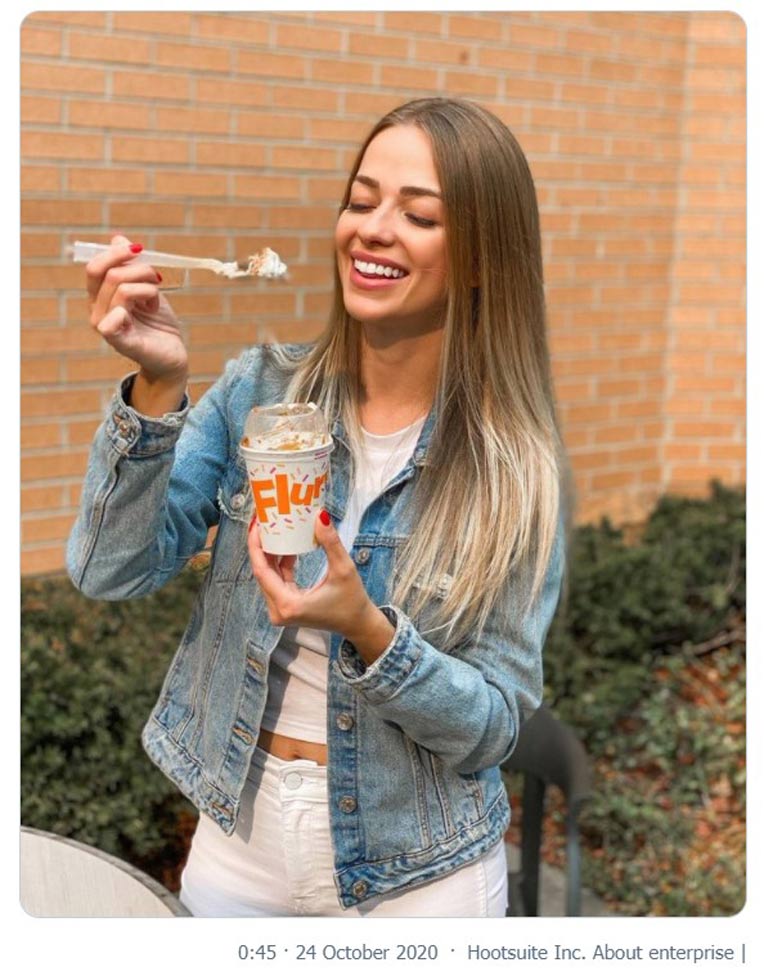Using influencers to promote your products is not a modern concept. Back in 1760, Josiah Wedgewood received a royal blessing from Queen Charlotte for a china tea set he made for her. A favorable reception he made sure to share widely, which delivered him commercial success.
Free Download: 150 Micro-Influencers In Every Niche
Today, you don’t need a royal seal of approval to benefit from influencer marketing. Widespread social media usage means there are countless thousands of people you could hire to influence others to buy your products.
This article focuses on the social media platform most think of first when the topic of influencing comes up – Instagram.
Using Instagram influencers can be great for business. Instagram’s users spend an average of an hour a day on the platform, and the latest research shows that Instagram’s younger audience is more likely to trust the recommendations of influencers over the brands themselves.
So let’s take a look at how you go about finding an Instagram influencer to promote your business’s products.
What Are Your Goals?
When you start, you need to define your goals for working with an Instagram influencer.
Your goals will determine your budget and potentially the type of influencer you hire. So before you begin hunting on Instagram for possible collaborations, take a moment to jot down your desired outcomes from the campaign.
There are three broad types of influencing campaigns. Each type aligns with typical stages in the sales funnel:
Awareness stage
At the launch stage of a product or brand, you can use influencers to raise the awareness and profile of your new venture. Influencers can help to communicate the key benefits of your product and help to build trust in your brand.
Informational/Decision stage
You can use Influencers to persuade their audience to sign up for a trial or direct them to a lead magnet so you can capture email addresses. They can also highlight features and how your product is superior to the competition.
Making a sale
There are, of course, bluntly transactional influencing campaigns too. The influencers say; ‘I like this product, you should buy it from here.
Once you know the aims for your campaign, next, you need to determine the type of influencer that’s most suited to your goals and budget.
Types of Instagram Influencers
You can broadly categorize influencers into two different types – macro and micro. And allocation to either category depends on the number of followers they have. A micro-influencer is usually considered to have between 5k to 100k followers, and macro-influencers over 100k followers (some in the influencing business use different follower count ranges).
There are positives and negatives to choosing each type
Micro-Influencers
A micro-influencer will often upload niche-specific content on Instagram, enabling you to reach a distinct segment of people who already display an interest in your product type.
You can usually also expect micro-influencers to have a more engaged following.
Engagement on Instagram can be measured and expressed in percentage terms. It is calculated from the proportion of followers who interact with the content, either by leaving a comment or giving a like.
An influencer with an engaged following is desirable for your campaign and should result in more bang for your buck.
Micro-influencers are also cheaper to work with than macro-influencers. So, find micro influencers that suit your brand and hiring them won’t cost a fortune, yet you will get the desired results.
Macro-Influencers
Choosing a macro-influencer brings a different set of benefits. More followers mean a more widespread reach for your campaign. Plus a larger following will also reduce the danger that the influencer has simply bought a large proportion of their followers, which can be a pitfall with some micro-influencers.
The experience of working with a macro-influencer should be more professional – they know the ropes and how to conduct the transaction. Additionally, you may find it less stressful working with a single macro-influencer rather than managing several micro ones.
On the downside, working with a macro influencer will be more expensive—possibly more costly than working with many micro-influencers. Choosing a macro-influencer is a high-risk/high-reward strategy. Get it right, and you could be on to a winner. Get it wrong, and you’ve wasted marketing resources.
Whichever route you take, you need to know your ideal audience and choose an influencer that will resonate with your brand. For example, I’m in the lifestyle business niche, and Instagram is full of beautiful travel accounts I could leverage for my brand.
But, many of the accounts are from 20-something nomad couples canoodling in (extremely) blue waterfalls. My brand is for 40-something traveling entrepreneurs, more likely to be bundling two kids and three bags onto a bus to find the nearest hotel with WiFI, than hunting down aquamarine waterfalls.
For my promotions, I choose influencers that resonate with my audience, rather than romantic ideals.
Finding Influencers, Manual Search, or Tools?
You can start your search for an influencer by looking through hashtags you associate with your brand. The desktop version of Instagram conveniently separates the top posts from the more recent posts. And you can also hover your mouse over each picture to quickly find out what sort of user engagement each update received.
Bring up the account page for posts with potential and look to see how many followers the user has. I’d recommend aiming for a minimum of 5000. It’s worth also reviewing the ratio between the number of ‘followers’ and the amount the account is ‘following’.
The average person follows 150 accounts on Instagram. So a high ‘following’ number can indicate that the account holder is participating in follow-for-follow account building, and they will have a less engaged audience.
When you find an account, copy the name to a spreadsheet and keep looking for some more. You’ll need to find plenty of possibilities before you begin your outreach.
If you don’t fancy manually trawling through hundreds of hashtags to discover ideal influencers, there are many tools available that help speed up the process.

Influencer Search Tools
Influencers Club is the largest influencer data provider with over 70M validated contacts. Every contact has their number of followers included, along with data points like Instagram bio and category that are publicly available and help better understand the interests of each person.
To get a glimpse of the influencer lists you can use the search tool below to find influencers based on any specific text or keywords in their Instagram biography.
Additionally, one of their tools offers brands the option to enrich their current customer and subscriber email lists and discover Instagram influencers among them. It’s pretty much the smartest way of doing influencer marketing because you skip the painful process of researching and choosing the right influencers.
Pitching your brand and products to influencers that haven’t heard of you is another issue that’s gone using this approach. And lastly, you don’t need to worry anymore whether your influencer will “get” your brand and deliver the message you want. All of this is gone when collaborating with people that know and love what you do.
On average from 100 emails (from a worldwide audience) the program can identify 4 Instagram users with above 1k followers.
If you like the idea of turning your customers into influencers and you run a Shopify store, there is an available plugin to help you do just that. We know how to find Instagram influencers to promote your Shopify store, but also we can provide social information for customers who purchased from your store.
Review the social media standing of your customers then contact potential influencers and see if you can strike a deal.
Building Relationships
Your net worth is a reflection of your network, or so the saying goes. So to benefit from influencer marketing, you have to get out there and connect with people.
Cold emailing a prospective influencer may work in some cases, especially if it’s a small transactional deal you are looking for with a micro-influencer. But influencers with more social authority may need a little TLC before they agree to do a deal.
Make sure to follow your best targets for a period and comment and like their content, before you reach out with an offer. Hunt down your top targets elsewhere too. Do they have a blog, Reddit, or Facebook account where you can interact with their content?
Be authentic, though. Good influencers know what they are doing and the value they can deliver you. A hamfisted approach, full of flowery praise, will stick out like a sore thumb. Keep it cool and professional.
You can also irritate a potential influencer if you demand total creative control over a campaign. The influencer will have carefully managed his or her social profile, possibly over many years, so if you seek to alter their online persona, the relationship may come unstuck.
If you can’t spare the time to do all this groundwork, you can choose to use an Influencer Agency, instead. Adding in a third party will increase the cost of the process, but you’ll work with experts in influencer marketing, which will hopefully deliver quick, positive results.

How to Pitch to Influencers
Influencer outreach needn’t be difficult if you stick to a few dos and don’ts.
Your pitch should have a solid value proposition. Can you create a special offer for the influencer’s audience that makes the influencer look amazing in the process?
You should be upfront about what compensation you are offering too. This will likely mean money, and if you offer to only ‘raise their profile’, you could offend – most people think their time and their audience are worth more than just a ‘shoutout’.
Don’t pitch a collaboration directly to potential influencers in their Instagram comments; it’s unprofessional and likely to fail. Pitching via DM is fine, or if your target has an Instagram business account, you can contact them by their email address.
If you pitch via DM, keep the message casual and as brief as you can. An email pitch can be longer, but should still be short and to the point. Follow the usual cold pitching guidelines when you reach out.
Start with a personal greeting. I get regularly contacted by people who want to work with my brand, and their messages begin; ‘Hey there…’. It takes a few seconds to track down my name – names are everything! So take a moment to find the names of your targets.
It’s good practice to include a sentence that shows your appreciation of their content, which demonstrates, at the very least, you’ve taken a moment to study their account and aren’t just mass-spamming out pitches.
Next state your proposition, tell them what you do and why you are contacting them. Outline your proposed collaboration, and ask for a response.
Make the pitch feel like a true collaboration between you and the influencer. If you give the impression that you are doing them a favor, don’t be surprised if your pitch falls flat.
It may require persistence to land your desired influencer. Your first approach may have arrived at the wrong time and went unread, so a little tenacity can sometimes pay off.
Make sure to keep a record of your targets and outreach campaigns as you go along. A simple spreadsheet might be all you need, but some of the tools for finding influencers also provide a CRM to help you manage the process.
Finally, it is a numbers game. Like any cold outreach, you may only receive as little as a 5% response rate. Don’t dwell on a couple of potentials, seek as many targets as possible, and be organized with your pitching.
Influencer Campaigns for Inspiration
McDonald’s.
Think that the big brands only work with macro-influencers? McDonald’s ran a campaign for a new CHIPS AHOY! McFlurry using influencers with smaller follower counts. In the example below, Jeniraitz at the time of writing had only around 47k followers.

It’s an excellent example of an overtly transactional influencer campaign, and is reminiscent of most soft drink commercials; pretty girl consumes the product.
Dunkin Donuts.
Dunkin Donuts promotes their fall menu and makes the food the star in their collaboration with foodie influencer closetfatgirl. The campaign also fits in with the rest of her content; she often includes video closeups of food that’s not always good for your waistline. It will be important to many influencers that a sponsored post’s style syncs with their online persona.
Sports Research.
Sports Research, family-run health, and wellness companies use micro-influencers to build awareness for their brand. Brittanybymafit can only claim 1.5k followers at the time of writing, and I dare say that the cost for the promotion may have been likely a free sample of the product.
Ample Harvest.
Influencing is not only for profit. Ample Harvest aims to end hunger and food waste and partners with growers to use excess produce for a good cause. As an awareness campaign, it rates well. A good image with the bold colors of a bountiful harvest helps to spread the message of their charitable work.
Final Thoughts on How to Find Instagram Influencers
Hiring Instagram influencers to promote your products can be an effective use of your marketing resources.
Begin by thinking about your overall aims and goals for the campaign. Your goals may inform whether you shoot for the stars and hire a macro-influencer, with the risk and reward it can bring, or focus on micro-influencers for a more budget-friendly approach.
Whether you choose to search for influencers manually or using a tool, approach your targets professionally. Influencers understand the benefits they can provide to businesses, and will want to feel that their content ideals are being respected.
Don’t get hung up on hiring a specific influencer. There may never be a perfect match for your business, so play the numbers and be organized with your outreach.


